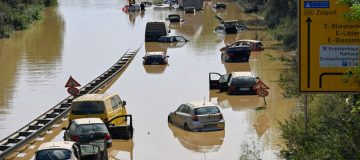Michiel Willems
Scotland should not be seen as a world leader on climate change, as the Scottish Government claims, according to climate activist Greta Thunberg.
The Swedish teenager said she has not yet decided whether she will travel to COP26, the global UN climate conference in Glasgow next month, but will do if it is “considered safe and democratic” – including ensuring participants from poorer countries are fully vaccinated and able to travel.
Questioned this morning by BBC Scotland on whether Scotland is a world leader on climate change, she said: “No… I mean, there are some countries that do a bit more than certain others, but then if we look at it from a broader perspective then I think we can safely say there are no countries – at least in the global north – that are even doing close to what would be needed.”
Scotland’s climate change legislation includes a target to reach net zero by 2045, which the Scottish Government has said is “world-leading”.

Also Read:
Cop26 is our last chance to tackle climate change as extreme weather takes hold
The 18-year-old was also sceptical of the Scottish Government’s new power-sharing deal with the Scottish Greens which will bring Green representatives into government for the first time in the UK.
Thunberg told the broadcaster: “Of course there might be some politicians that are slightly less worse than others. That was very mean, but you get the point.”
“It’s a hopeful sign that people want something that’s more ‘green’ – whatever ‘green’ means – but in order to solve this, we need to tackle this at a more systemic approach,” she added.
Return to school
Having returned to school after a year out leading young people in school strikes for climate change, Thunberg said the conference falls in her school holidays, and if she does attend she plans to travel by train.
On whether the conference should be in person or virtual, she said: “We get much more results when we meet in person, it’s hard to argue against that, but of course if it’s not considered safe then we have to go for the safest option.
“To be honest, I don’t think that either one will lead to much results. A physical meeting will probably bring more results, but still nowhere close to what’s needed.”
Asked if she was optimistic for the future, she said: “I don’t know whether ‘optimistic’ is the right word, but it gives me at least hope to see we have a huge potential of achieving change.
“We know that change will not come from the Cop, from within these negotiations. The change will come when there are enough people outside on the streets demanding change.”
Questioned on the controversy over plans for the new Cambo oil field west of Shetland, she said: “I think that maybe summarises the whole situation we are in – the fact that these kind of countries who are actually hosting the Cop is planning to actually expand fossil fuel infrastructure, to open up new oil fields, and so on.
“But also it’s a bit strange that we are talking about single individual oil fields.
“It’s not just that we need to stop future expansions. We also need to scale down existing ones if we are to have a chance of avoiding the worst consequences.”

Michiel Willems
The Scottish Government’s new power-sharing deal with the Scottish Greens will bring Green representatives into government for the first time anywhere in the UK.
Nicola Sturgeon plans to set out details of her government’s deal with the Greens as Holyrood returns after the summer recess.
The first day of business is also expected to see Patrick Harvie and Lorna Slater formally appointed as junior ministers in the Scottish Government, the first time ever Greens have held such positions anywhere in the UK.
It comes after a co-operation agreement between the two pro-independence parties was endorsed by the members of both organisations this weekend.
As a result, Harvie will become the minister for zero carbon buildings, active travel and tenants’ rights, while Slater – a renewable energy expert who was became an MSP in May – will take on the role of minister for green skills, the circular economy and biodiversity.
Sturgeon said the “historic cooperation agreement” between the two parties was founded on “a shared drive to work together in the Scottish Government to build a greener, fairer, independent Scotland”.
Independence debate
Meanwhile SNP MSP Neil Gray said the deal could see the people of Scotland given the chance to vote again on the issue of independence.
He stated: “Our Scottish Parliament was built on the founding principles of working together and collaborating and we should all come together for the future of Scotland.
“As we recover from the pandemic we can focus on creating good, green jobs to support our just transition.
“We can build a social security system that is built for the people of Scotland, not against them. And we can give the people of Scotland a choice over their future in an independence referendum.”
But Scottish Conservatives have vowed to vote against the appointment of the two Green Party co-leaders to the government.
Tory Covid recovery spokesman Murdo Fraser said: “In the middle of the biggest economic crisis in our lifetime, it’s deeply worrying that Nicola Sturgeon is turning to anti-jobs, anti-business extremists.
“It is pure economic vandalism to hand power to Green MSPs who have admitted they want tolimit growth and hold back Scotland’s economy.
He added: “Nicola Sturgeon is taking a nationalist gamble with people’s jobs. She is bringing in radicals, all in the hopes of ramping up her push for another divisive referendum.
“Only the Scottish Conservatives will stand up and challenge this divisive coalition of chaos and provide a real alternative to end the obsession with independence.”


















